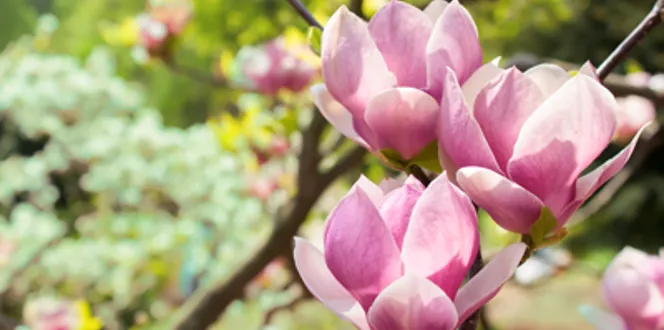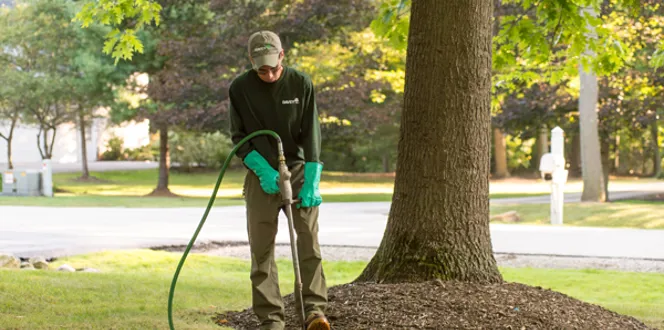Flowering trees are the superstars of your landscape. They bring vibrant color throughout the seasons. From the pink dogwood’s delicate, blushing petals to the Southern magnolia’s big, white blooms, they all make you smile.
On the road to the best blooms on the block, regular tree care is important. Providing adequate, annual fertilizer is part of the maintenance that helps grow a healthy flowering tree.
While you may have heard about fertilization’s importance, you may not know a lot about when to fertilize flowering trees or what approach is right.
Let’s tackle the basics on fertilization timing to ensure you have all the knowledge you need for your flowering tree care.
Why You Should Fertilize Flowering Trees Year-Round
Fertilizing flowering trees can enhance your landscape aesthetics. Why? Because it encourages blooms, while increasing healthy growth. Fertilization strengthens trees by promoting a healthy root system. It provides important nutrients and it supports tree vitality.
More good news: Lush, thriving trees can boost your curb appeal and home value.
Benefits of Fertilizing Trees
Trees that grow in forests get natural fertilizer with the recycling of fallen leaves.
In your yard, leaves are often swept away. Trees also have to compete with grass sometimes for nutrients.
That’s why fertilizing your flowering trees with a slow-release fertilizer is important, replicating this natural process trees in the forest go through.
Because slow-release fertilizers release nutrients over time in a consistent manner, timing is less important. However, certain seasons bring benefits, based on your location.
In spring, fertilization supports new growth during the biggest season for it, supplying nutrients the tree needs to stay healthy. In fall, fertilization can help the tree recover any nutrients that were lost during the summer, as well as promote root growth during the winter if the soil isn’t frozen in places like warmer states.
When to Fertilize Flowering Trees
When it comes to your favorite flowering trees, you might be wondering about the absolute best times that suit them when fertilizing.
Using a slow-release fertilizer annually on all tree species is best done in early spring approximately two weeks before trees bloom. That way they receive the nutrients they need throughout the growing season. There is no need to reapply fertilizer later in the summer. Your local arborist is always able to give you the best advice when it comes to the perfect slow-release fertilization timing for your flowering trees.
Here are general bloom times for some common flowering trees so you can get a better understanding of fertilization timing. Remember, these times can vary based on regional differences and weather conditions.
- Flowering Cherry Tree -- Average peak bloom is when 70% of the flowers are open, which averages in early April, but it has occurred as early as mid-March and as late as mid-April. The blooming period lasts approximately 14 days.
- Flowering Dogwood -- These trees typically bloom between April and early May.
- Flowering Crabapple Tree -- Spring flowering happens during a two-day to two-week period from April to June.
- Flowering Pear Tree -- Tiny white flowers appear on this tree in March or April.
- Flowering Plum Tree -- These trees bloom from February to April with small, fragrant light pink or white flowers.
- Flowering Peach Tree -- Flowering for plums starts in February or March, depending on the variety and local weather conditions.
What is the Best Tree Fertilizer?
Fertilizers designed for a slow-release nutrient application -- also known as slow-release fertilizer -- are best for flowering trees.
Davey arborists prefer Arbor Green PRO in Northern and Western regions because it uses three key macronutrients (nitrogen, phosphorus, and potassium), mimicking the forest environment.
Flowering trees in the Southeast often face additional micronutrient challenges, such as potassium and boron deficiencies, so Davey arborists prefer Arbor Green Xtra plus B, which offers both macro- and micro-nutrients.
In addition to fertilization, sometimes micronutrients imbalances can prevent your flowering trees from blooming. Professional guidance from your local certified arborist, along with a soil test, can determine any deficiencies so your arborist can use that knowledge to help improve your soil.







